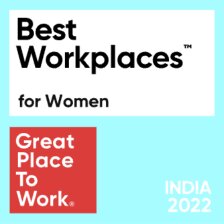Managing Healthcare Workforce Burnout Risk with Empathy & Technology
Overview
Triggered by the COVID-19 pandemic and rising expectations of people from healthcare workers to be more patient-centric, the global healthcare system is on the cusp of burnout today. In the last two years, when the pandemic was at its peak, healthcare providers across the world underwent trials and tribulations not everyone can understand. Lack of rapid testing equipment, patient facilities, and increasing demand for efficient services pushed healthcare workers to overburden themselves and make personal sacrifices for the global good.
According to a Washington Post/Kaiser Family Foundation survey of more than a thousand front-line healthcare workers in the United States during the COVID-19 pandemic, an overwhelming 55% of front-line healthcare workers reported mental and physical exhaustion from chronic workplace stress. Symptoms like lack of sleep, anxiety, continuous fatigue, and frustration, if left unaddressed can lead to deeper mental and physical health issues.
How Healthcare Worker Burnout is Impacting the Talent Landscape
While limited staffing was always a challenge, the current landscape looks far more intense in terms of a consistent shortage of skilled staff to effectively handle unforeseen events, thanks to the Great Resignation, a trend that has encouraged employees worldwide, including many in the healthcare segment, to quit to improve their work-life balance. Many of those still in their jobs are also considering leaving the field, adding to the worries of employers who see growing demand for care without enough hands at the bedside to cater to their patients.
Healthcare is a specialized field and requires qualified, well-trained, and credentialed professionals to discharge duties. Organizations invest significantly in training human resources to meet their patient care and other supporting needs. An exodus of trained talent is not only affecting their care standards but also reducing their returns on investment.
Solving The burnout Challenge with Technology and Empathy
As per the Gartner report, the pace of innovation and change is unlikely to abate. Only healthcare companies with the ability to adapt and rapidly respond to the market’s demands will only succeed.
To do this, they will always need the best digital talent. At the same time, they must not lose focus on filling patient care and other related roles. In a tight jobs market, targeted talent sourcing followed by rapid screening can help in attracting the front-line talent.
With a trend of “The Great Resignation” accelerating faster than expected around us, offering tailored packages and non-financial benefits can open doors for an in-flow of the right talent.
While getting the right talent is the first step, ensuring that it is retained successfully requires consistency in the support provided after the talent is onboarded. This shows why healthcare companies now need not only to redefine their talent acquisition models but also to look at leveraging innovative technologies to enhance talent engagement.
Diving Deep: Talent Retention
Employee retention is key to the overall and financial health of any organization. A report published by the Bureau of Labor Statistics, employment in the US is projected to increase by 11.5 million from 2016 to 2026. The healthcare sector and its associated occupations are expected to add nearly four million jobs, accounting for approximately one-third of all new jobs.
While talent acquisition and retention is a matter of concern for any industry, the healthcare industry gets hit the most with a lack of skilled resources. Key challenges despite tapping into the flexible workforce for healthcare are: Seasonal labor fluctuations, lack of tech-led systems, and management of acuity needs and providing for unforeseen scenarios.
Consistent engagement is an effective strategy to boost employee retention. While human interactions are pivotal to engaging healthcare workers, AI-driven tools can help in streamlining the engagement. Features like push notifications, automated interactions, and Machine Learning algorithms that help in personalizing messages, can amplify the impact of an employee engagement program.
How Technology Can Solve
Technology is paving the way to transform the talent acquisition process. At the ecosystem level, technology innovation will include cloud-hosted platforms integrating hospitals and payers with patient data including sources such as wearables, to help deliver personalized patient care services that are faster, cheaper, and more accessible.
Thankfully, when it comes to hiring or screening the right candidates, the new-age technology is already a step ahead. Let’s see how it can address and solve the talent shortage crisis:
– Supporting Staffing Process E2E: Technology can support the entire process of resource optimization, from candidate screening to mid-level evaluation and onboarding. The trifecta of AI, Automation, and Analytics can help companies with every essential detail from job description matching, and resume screening, to streamlining processes through Applicant Tracking Systems (ATS) and monitoring candidates to interviewing the best candidates and measuring responses strategically.
– Solving Visibility Crisis: Shortage of physical resources can be anticipated better when the dashboard figures start moving. A digital dashboard supported by analytics can show how the resource activities are logged in and provide useful insights into their behavior. Moreover, with analytics, you can be one step ahead in the talent management game, purely based on data, which can help in enhanced communication and engagement with the employees, understanding their concerns, and improving retention, which is the real objective.
Enhancing Employee Satisfaction To Lower Attrition: Implementing technology solutions to automate iterative workflows and reduce manual operations will significantly reduce the healthcare staff workload. Organizations must strategically invest in digital transformation to improve patient as well as customer experiences. This will improve worker satisfaction, enhance their employer brand, and positively impact the retention rate.
– Innovative Technology To Leverage Effective Referral Strategies: New-age recruitment tools & technologies can not only deliver simple, convenient, and transparent services, but they can augment human judgment and enable data-driven decision making, leading to superior healthcare outcomes and optimal talent retention. Smart referral networks that instantly broadcast job requirements to a vetted pool of industry specialists can help in harnessing the power of referrals to reach high-quality passive talent.
– Amplifying Talent Outreach Through Crowdsourcing: Healthcare organizations can reach more qualified talent by utilizing the expertise of external recruiters. This can be done through crowdsourcing platforms that can rapidly mobilize external recruitment specialists can help expand your talent outreach.
Partnering with a Healthcare Workforce Solutions Specialist is the Best Strategy
Technology is your secret weapon for hiring and retaining talent. You can scale easily with a staff who is driven by higher engagement and enhanced efficiency. But investing in digital transformation and recruitment technology at the same time can be an impractical ask for healthcare organizations.
This is where a specialized healthcare staffing agency like Compunnel Healthcare that understands your unique healthcare recruitment needs, can turn out to be helpful. Our omnichannel sourcing strategy supported by our proprietary smart talent referral network and crowdsourced recruiting platform helps healthcare agencies to reach the right candidates early. Our internally-developed ATS, Staffline ATS is the pivot for candidate lifecycle management providing efficient support to our specialized recruitment team.
Get in touch with us today to learn how these solutions can help you make the right decision.








